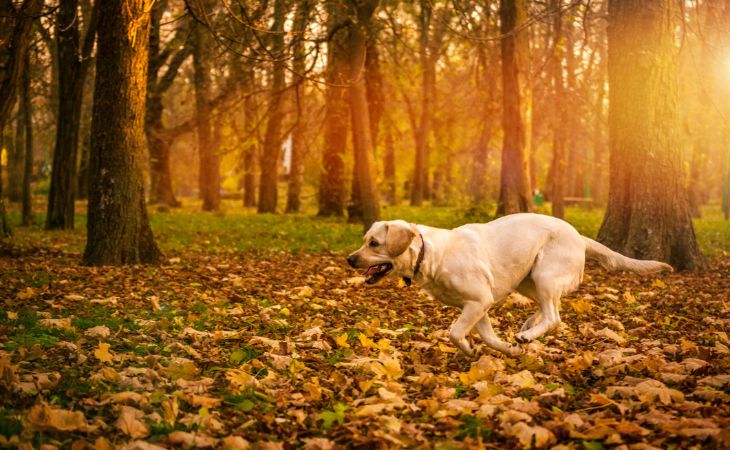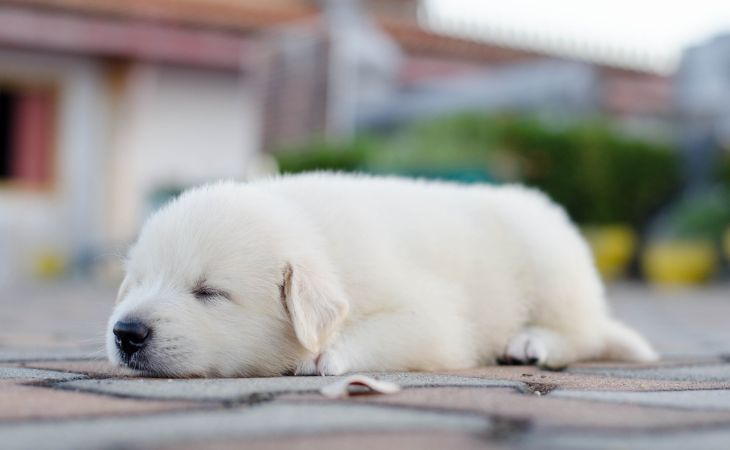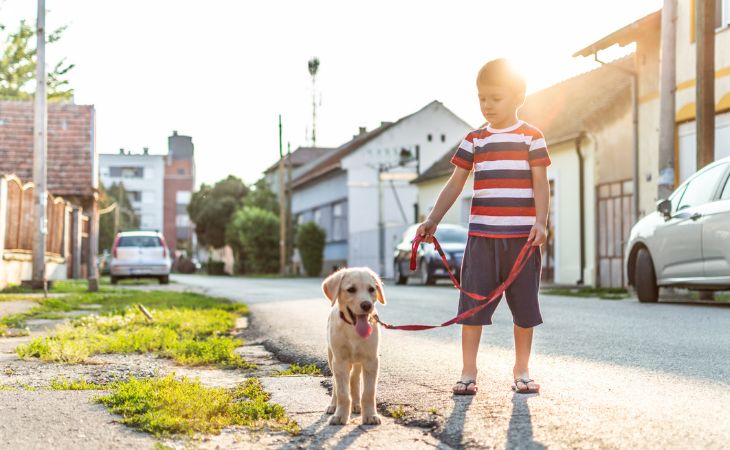Breed: Labrador Retriever | Size: Medium | Average lifespan: 10+ years | Character: Loyal, gentle, and playful | Coat: Short | Origin: Canada, United Kingdom.
The Labrador Retriever is one of the most popular and well known breeds. They are easy-going and sociable dogs.
The origins of the Labrador Retriever
St. John’s water dog, the ancestor of the Labrador Retriever
During the 18th century, St. John’s water dog lived on the island of Newfoundland. Their ability to retrieve nets of cod in deep water made them stand out and be very appreciated by fisherman.
Taking over England
St. John’s water dog was brought to England in 1814. English people quickly noticed the qualities of this dog and decided to cross them with the Pointer. This is believed to have started in 1822. The water dog was named Labrador Retriever by the county of Malmesbury. They were raised and trained to fetch things, notably waterfowl, confirming their status as retrievers.
A very polyvalent dog
Since their start as hunting dogs, the Labrador Retriever developed a certain polyvalence. This is thanks to their bravery, courage, and their receptiveness to training. Their strong sense of smell allows them to be able to search for narcotics. As they are patient and attentive, these dogs are often used as assistance dogs: for example, as guide dogs for the blind or as mediator dogs for patients in the hospital and seniors at retirement homes.

The Labrador Retriever’s character
The Labrador is a loyal and gentle dog, but also very helpful. These canine companions are attentive to their family. They are great family dogs.
What are the Labrador Retriever’s qualities?
Naturally very joyful, this dog breed is sociable, balanced, and loyal. Their patience combined with their natural playfulness and friendliness make them an easy-going companions who are close to their humans. They are also great guardians.
This is a dog of exceptional character, as they are always eager to help and please their owners. They are happy to accompany their owner on walks and sporting activities. These dogs are outdoor dogs: therefore, they need to let off steam and are at their best when they are given free rein to their retriever instincts. They love water, and will wade in water, throw themselves into the waves of the sea, jump into rivers, and so on. Among dog sports, flyball, for example, is one of their favorite activities, and retrieving.
Are there any downsides to having a Labrador Retriever?
Labrador Retrievers prefer the countryside more than the city. However, they can adapt to living in a city if their needs for exercise are fulfilled. Solitude can take a toll on this dog, making them become turbulent if they do not receive the attention they need.
The Labrador Retriever is also a dog that loves to eat, having a tendency to become overweight if their owners are not careful with their diet and do not allow them to get another exercise. It’s better to avoid leaving out food or other appetizing foods, as they might try to get their paws on it.

The physical characteristics of the Labrador Retriever
General
The Labrador is a solidly built, with strong and powerful muscles. With that being said, they are not too heavy. These dogs are resistant to exterior conditions, robust, strongly structured, and have a sporty morphology. However, they have a peaceful allure.
Head
These dogs have a medium-sized round head and straight muzzle. They have a pronounced occipital hump. This gives way to a clean stop and then a slightly curved nose bridge.
The nose of the Labrador is dark, except white and red dogs, with large and humid nostrils. This dog breed’s large muzzle, flat cheeks, and plump lips give them a friendly air.
When it comes to their ears, they fall on the sides of their head, with a triangle form with ends that are a little rounded. Their eyes attract looks, filled with gentleness, are medium-sized and brown or hazelnut colored.
Body
From the side, the Labrador Retriever has a body that is almost as long as it is high. The neck is muscular and a bit arched. The line of their back is straight. Their loins are muscular, and their chest goes down to their elbows or slightly lower. When it comes to their ribs, they are with well-developed and rounded. From the front, the chest is broad and high.
Labrador Retrievers have straight forelegs. When it comes to their back legs, the Labrador’s broad, muscular thighs allow them to lunge with ease. The tail, which is carried over the back, is thick at the base and tapers at the tip.

Labrador Retriever: coat, colors, and care
Coat
This dog breed has a short coat, around 1 to 1.5 cm long. They have a waterproof undercoat that naturally protects them from bad weather conditions. The coat is smooth, shiny, and not wavy.
Colors
The coat of the Labrador Retriever can be different colors: completely black, yellow, or brown. The yellow ranges from a light cream to a russet color.
Caring for and grooming a Labrador Retriever
To begin with, grooming the Labrador Retriever is relatively easy. Outside of molting periods in the spring and autumn, brushing them once a week is enough. However, you need to be careful about taking care of their ears because Labrador Retrievers can be prone to ear infections. Because of this, clean their ears regularly with a product recommended by your vet.
To take good care of your dog’s dental hygiene, it is necessary to get used to having their teeth brushed from a young age. In addition to this, give them toys that can fulfill their need to chew.
Even though the claws of the Labrador Retriever wear down naturally through outings with their owners, they can sometimes get too long. In this case, they can bother or hurt your dog. If they are too long, they need to be trimmed.
Did you know?
People often confuse the Golden Retriever with the Labrador Retriever, but these are two very different breeds. Learn more about the Golden Retriever here.
You might find this article interesting: Differences between the Labrador Retriever and the Golden Retriever
The Labrador Retriever at a glance
Size: 51 to 59 cm at the withers.
Weight: 25 to 36 kg (≈ 55.1 to 79.4 lb).
Health: Naturally gluttonous, Labradors can become obese if their diet is not supervised and their owners do not make sure they get enough exercise. It’s important to provide them with food that’s suitable for their needs (both regarding quality and quantity). It’s also necessary to make sure they go out regularly for physical exercise. This reduces the risk of developing joint problems, the most common of which are hip and elbow dysplasia.
These dogs can also have eye problems, such as retinal dysplasia, cataracts and retinal atrophy.
You’ll need to choose your kennel carefully and make sure the parents of your dog are free of these issues, so you can adopt a healthy puppy.
Average lifespan: 10 to 15 years.
Is the Labrador Retriever good with children? As they are gentle and patient, Labradors can be good family dogs, provided certain precautionary and safety rules are observed. These include never leaving a small child alone with a Labrador Retriever, regardless of breed, even if the child is conciliatory and has never shown aggression.
Is the Labrador Retriever easy to train? As these dogs are attentive to their owner’s demands and willing to learn, Labradors are easy to train and suitable as a first dog. However, as Labradors have a tendency to be exuberant (especially when they are still puppies), they need to be trained gently and firmly to create an environment and framework conducive to learning.

